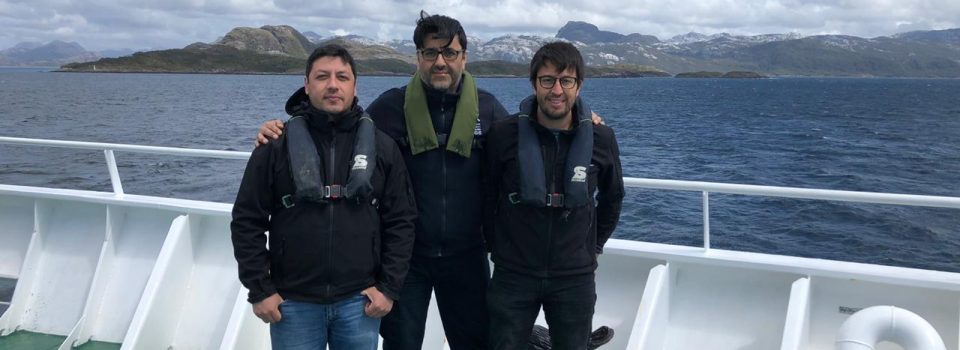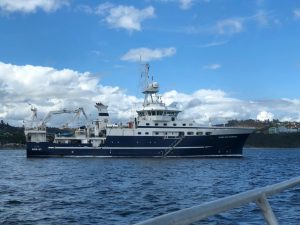IFOP scientists participate in an international cruise to investigate Harmful Algal Blooms (FANs) in Chilean Magellan and Antarctic region
December 5th, 2019César Alarcón, Pablo Salgado, Jorge Mardones and Gemita Pizarro are part of this unpublished study
Between November 13th and 24th, a team of 23 researchers embarked on Cabo de Hornos AGS-61 Oceanographic vessel, on the cruise called, “Magallanes and Chilean Antarctic region Glacier-Oceanic Prospecting of Harmful Algal Blooms Platform (PROFAN Magallanes) ”, with the objective of studying in an integral way harmful algal blooms in the Magallanes region, specifically toxin producing species, which have affected southern Chile coasts, in the Magallanes region fjord system and northern channels.
It was carried out by a multidisciplinary team of scientists belonging to different institutions, among them we can mention: Fisheries Development Institute, Universidad de Magallanes, Universidad Austral de Chile, Universidad de Concepción, Universidad del Biobío, Universidad Católica de Chile, Alfred-Wegener Institute of Germany, Stirling University from Scotland, Chilean Antarctic Institute, and Research in Ecosystems of Patagonia Center (CIEP). The Scientific Officer Chief of the cruise was Dr. José Luis Iriarte (Ideal Center – Universidad Austral). The study included 18 sampling stations located in the ocean and in the canals and fjords of the Province of Last Hope of the Magallanes Region.
Fisheries Development Institute experts on the participation in this expedition explained; César Alarcón “My participation in the cruise consisted mainly of obtaining qualitative phytoplankton samples with a net, up to 20 meters, for community identification, isolation and subsequent laboratory culture, in addition to quantitative phytoplankton samples obtained with oceanographic bottles at up to 30 meters depths, for phytoplankton quantification, together with obtaining total chlorophyll by filtration, to later determine it with a spectrophotometer and HPLC pigments analysis, and to obtain mollusks from the intertidal for existing toxins identification ”.
Pablo Salgado added ”The opportunity to tour fjords, canals and some more oceanic stations in the Cabo de Hornos Chilean Navy oceanographic vessel allowed, in my case, to obtain sediment samples that in another type of vessel would have been very difficult, Here we achieve depths of 545 meters.
My main task was to obtain superficial sediments by means of a dredge to see recent presence of dinoflagellates cysts, and also to obtain sediment witnesses through a HAPS Core to observe the record that microalgae have left over the past decades. ”
Dr. Jorge Mardones highlighted “IFOP team valuable participation, which had a multidisciplinary nature. My work, in particular, was focused on a line of research that I just started, which mixes phytoplankton photosynthetic properties and allelopathic / cytotoxic substances produced by toxic microalgae. The experiments on Cabo de Hornos board were carried out using a bio-optical measuring device called “Fast Repetition Rate Fluorometer or FRRf3” kindly provided by Plancton Andino SpA, environmental consulting company, which allows to determinate in real time toxic substances effect released by certain species of microalgae on the phytoplankton community present at a particular sampling point. The results, a priori, showed an intense toxic activity of Alexandrium catenella and Karenia selliformis dinoflagellates on the photosynthetic efficiency of the phytoplankton community in the northern part of the Magallanes region. These results have a great implication in the way we understand the appearance of these toxic species in the area of the Patagonian canals ”.
Dr. Gemita Pizarro concluded “This campaign has been a success in itself by complying with the planned and also for being the first time we achieved an interdisciplinary and inter-institutional oceanographic expedition around a problem such as harmful algal blooms, commonly known to people as “red tides.” Recall that in Chile it was in the Magallanes region where the first toxic and flowering event of A. catenella associated with its production, with socio-economic and public health effects, occurred more than 40 years ago.
In my case, although I did not participate in this international expedition because I was embarking on another of the international institutional expeditions also carried out in our region, I did have to organize it together with the leading colleagues of the joint project, UMAG, UACh and IFOP. The campaign was possible in one of the best equipped ships we have in our country, the AGS 61 Cabo de Hornos, in addition to the cutting-edge technology in some research lines of the participants in the expedition. I highlight the institutional support represented by the Department of Oceanography in Valparaíso and Puerto Montt through the Environment Department and the Harmful Algae Studies Center, CREAN. I feel that this particular campaign has left a good impression on everyone, the ability to work together, expectations of achieving greater progress and satisfaction in what we have to do.

